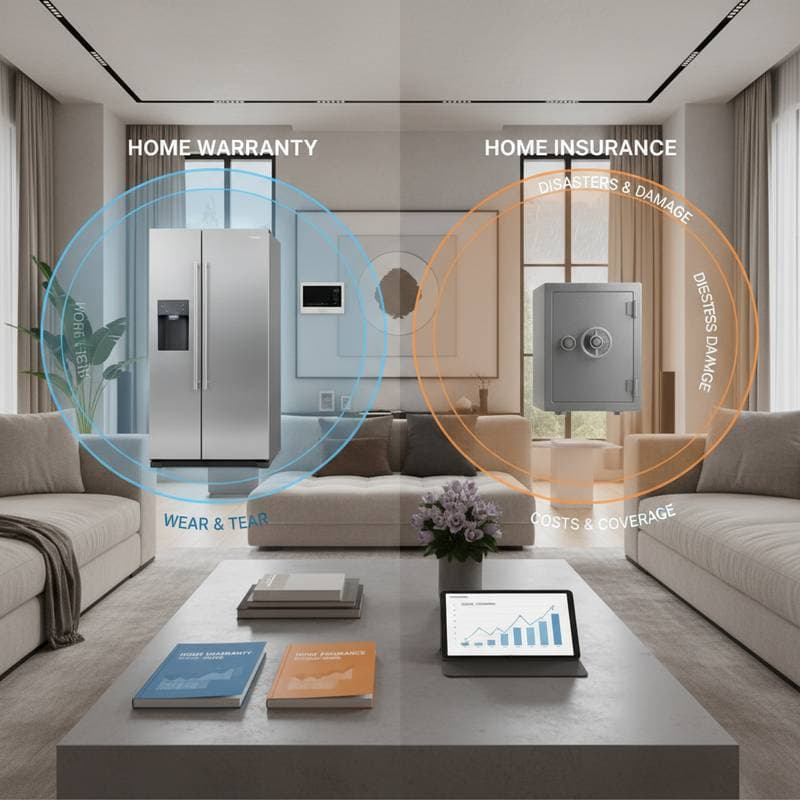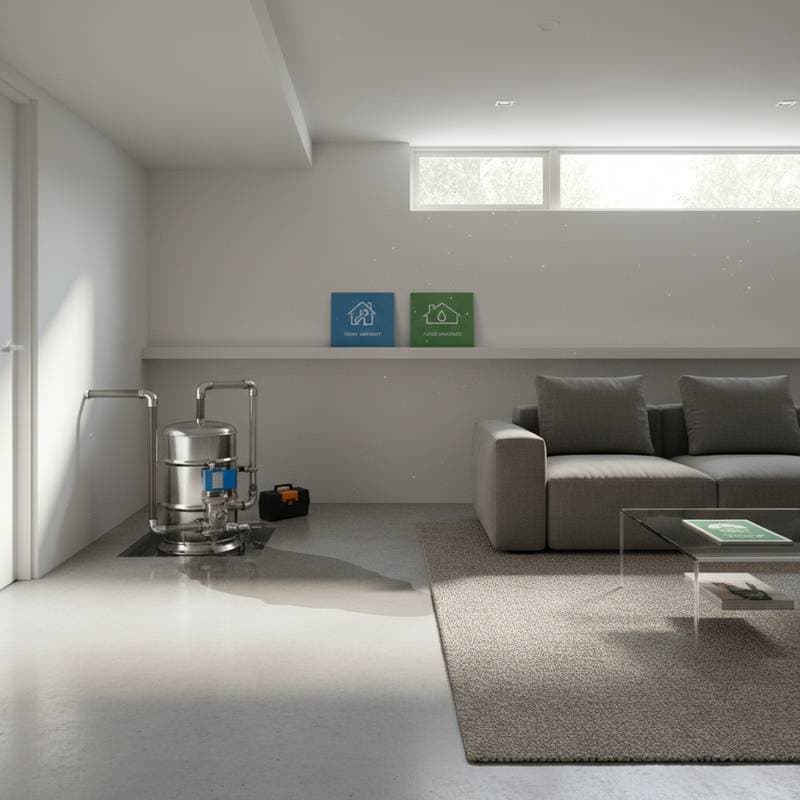Home Warranty vs Insurance: 2025 Coverage Secrets
Homeowners frequently mix up home warranties and home insurance policies. Each provides protection, but they address distinct issues. Grasping the specifics of coverage enables you to sidestep substantial repair expenses and ensure a robust financial safeguard. As advanced home systems and intelligent devices become standard, distinguishing these protections grows increasingly essential.
What a Home Warranty Really Covers
A home warranty functions as a service contract that covers repairs or replacements for major home systems and appliances that malfunction due to normal wear and tear. This plan targets components that degrade over time through everyday operation.
Standard items under coverage typically encompass:
- Heating, ventilation, and air conditioning (HVAC) units
- Plumbing pipes and electrical wiring
- Kitchen appliances, including ovens, refrigerators, and dishwashers
- Washing machines and dryers
- Garage door openers and related mechanisms
The warranty provider pairs you with vetted contractors. You cover a modest service fee for each service request, while the company manages costs up to the policy's designated limits. This approach converts sporadic, high repair bills into predictable, low-cost visits.
Example:
Consider a homeowner whose dishwasher motor fails after years of use. With a warranty in place, they pay only the service fee for the repair, avoiding a full replacement bill that could exceed $500. The provider coordinates the technician, minimizing hassle and downtime.
What Home Insurance Actually Covers
Home insurance safeguards the physical structure of your residence and personal possessions against unforeseen incidents, such as fires, theft, or severe weather events. The policy emphasizes abrupt losses rather than gradual deterioration.
Key coverage areas generally include:
- Dwelling coverage for the home's framework and attached structures
- Personal property protection for furniture, electronics, and other items
- Liability protection against injuries occurring on your property
- Additional living expenses to cover temporary relocation during major repairs
Lenders typically mandate this insurance to secure their investment. It maintains financial recovery following catastrophic events, yet it excludes routine mechanical failures.
Example:
Suppose lightning strikes and damages your air conditioning unit. Home insurance would likely cover the restoration costs. However, if the unit's motor simply burns out from prolonged use, a home warranty would step in to address that issue.
Key Differences That Matter
The primary distinction centers on the nature of the damage. Home insurance responds to sudden, external perils, whereas a home warranty manages failures stemming from ordinary use. Most property owners benefit from maintaining both to achieve comprehensive safeguarding.
| Feature | Home Warranty | Home Insurance |
|---|---|---|
| Covers wear and tear | Yes | No |
| Covers disasters (fire, storm, theft) | No | Yes |
| Required by lenders | No | Yes |
| Pays for appliance repair | Yes | No |
| Pays for structural damage | No | Yes |
Think of it this way: home insurance defends against threats originating from the exterior, while a home warranty maintains the internal workings.
Why Homeowners Combine Both
Layering these protections minimizes vulnerabilities across all fronts. Home insurance intervenes during crises to prevent financial ruin, and a home warranty ensures essential systems remain operational without interruption. This dual strategy eliminates unexpected outlays that could otherwise disrupt budgets.
Property owners often report enhanced security from this combination. Forum discussions highlight cases where warranties offset thousands in heating system overhauls that insurance overlooked. In contrast, insurance has rescued situations involving water intrusion that damaged subfloors, beyond a warranty's scope. Such accounts underscore the complementary power of integrated coverage.
How to Evaluate Plan Costs
Expenses fluctuate based on property size, geographic location, and inherent risks. Home warranty plans generally involve an annual premium plus a per-incident service fee. Insurance rates hinge on the home's appraised value, construction age, building materials, and prior claims history.
Follow these steps for a thorough comparison:
- Inventory your major systems and appliances, prioritizing those with high replacement values, such as a $3,000 refrigerator.
- Examine policy exclusions closely; certain plans omit pre-existing issues or coverage for niche brands like high-end European appliances.
- Verify payout caps, which might limit individual repairs to $1,500 or annual totals to $5,000.
- Inquire about service response times; providers aiming for 24- to 48-hour arrivals offer greater reliability during emergencies.
- Consult customer reviews and industry ratings to assess claim processing efficiency and overall satisfaction.
Visualize costs with a basic table: one column for yearly premiums (e.g., $400-$600 for warranties), another for uncovered repair estimates (e.g., $800 for HVAC tune-up), and a third for net savings (e.g., $300+ per covered event).
Hidden Coverage Gaps to Watch
Numerous owners assume total security, only to encounter limitations during claims. Frequent oversights involve:
- Appliances or parts absent from the explicit coverage roster
- Aesthetic damages, like dents on a refrigerator door
- Claims invalidated by neglected maintenance, such as unserviced air filters
- High deductibles that substantially lower reimbursements
Home insurance policies carry their own restrictions. Standard plans exclude floods and earthquakes, necessitating standalone riders that can add $200-$500 annually. Conduct an annual policy audit for both to preempt disappointments.
Expert Tips for Smarter Coverage
- Bundle policies where possible; insurers may discount combined packages by 10-20 percent.
- Maintain detailed records, including maintenance logs, appliance serial numbers, and invoice copies, to expedite approvals.
- Adhere to approved vendor networks; deviations can nullify claims and lead to out-of-pocket expenses.
- Understand processing timelines: warranty services often resolve in days, while insurance evaluations may span weeks.
- Explore add-on options; select warranty providers now extend safeguards to smart thermostats, security cameras, and connected lighting systems.
Common Questions Homeowners Ask
Do I need both home warranty and insurance?
Yes, for thorough defense. The warranty addresses operational failures, while insurance tackles peril-induced losses.
What if my HVAC fails from a lightning strike?
Insurance typically covers the strike-related destruction. Pure age-related motor failure shifts to warranty responsibility.
Can I cancel a warranty anytime?
Providers generally permit cancellations, though fees of $50-$100 may apply. Review contract fine print prior to commitment.
Are older homes harder to cover?
Certain plans restrict systems over 10-15 years old or require inspections. Clarify these details upfront.
Does insurance cover appliance replacement?
Replacement qualifies only if tied to a covered event, like a fire. Normal wear remains uncovered.
Real-World Value of Having Both
In a hurricane-prone region, one owner utilized their warranty to replace a faulty washing machine component for under $100. Subsequently, storm winds tore shingles from the roof, prompting a full insurance payout that averted $10,000 in costs. This scenario illustrates the tangible benefits of overlapping protections.
A Midwest family recounted three warranty interventions within a year: plumbing fixes, oven repairs, and dryer servicing, each limited to the service fee. Absent the plan, these would have totaled over $2,000, preserving their financial stability. Layered approaches prove indispensable for everyday resilience.
Making It Happen
Begin by assessing your current setup. Retrieve your insurance documents, catalog included protections, and note any gaps. Next, benchmark top warranty options, emphasizing straightforward costs, detailed coverage outlines, and dependable customer service. This methodical review positions you for optimal, worry-free homeownership in 2025.





